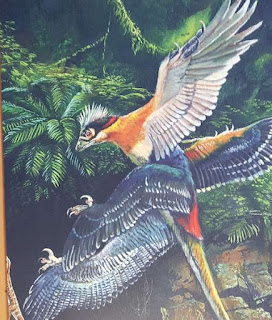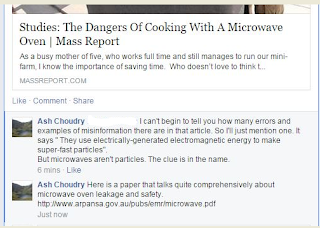We have not always been the alpha predator on this planet - Dr Hannah O'Regan give this month's public lecture on "Who's Eating Who? Hominins and Carnivores in Human Evolution"
@Gav Squires was there and has kindly written this guest post summarising the event, with some linkage added by NSB.
To begin with, why carnivores?
Social carnivores could be a good proxy for hominins and their development. They have been in competition with hominins for resources such as food, water and shelter. They are primate predators.
7 million years ago, the first hominin, Sahelanthropus, evolved. 3.9million years ago, we had Australopithecus, the best known example of which is Lucy and 3.3million years ago, we have the earliest archaeology with evidence at the Lomekwian site of the use of stones. Evidence has been discovered from 3.4million years ago of marks on bones, implying that humans had used tools to remove flesh, which they then presumably would have eaten. 2.8million years ago the genus homo made their first appearance and 2.6million years ago was the first use of stone tools. 1.5million years ago, we have Acheulan tools, hand axes and we have bipedal hominins wandering the landscape with tools.
Between 1 and 2million years ago there were a range of large carnivores in Africa including 6 types of hyena, canids including those the size of wolves and African dogs. There were also a number of felids that could take down a hominin including lions, cheetahs, leopards and sabre-tooth cats. Sabre-tooth cats were ambush predators with very powerful front-legs that they would use to wrestle prey into position so that it could use its teeth. The teeth were longer than they were wide, which made them susceptible to breaking. However, if they did break it would mean that the animal would be forced to scavenge and would not have lived for much longer afterwards. In Swartkrans in modern-day South Africa, evidence has even been found of human remains that have been predated by leopard.
As well as large carnivores, there is also predation by birds and things such as eagles will hunt primates - there is plenty of evidence in the form of primate bones beneath the nests of Crowned Eagles. The Taung child, the first ever fossil published of a hominin from Africa was discovered in 1924, was 3-4 years old when it died and the only hominin fossil ever found in Taung in South Africa. It has similar orbital damage to primates eaten by eagles and it appears that there was no population at Taung and the child was carried there by an eagle.
Evidence has also been found of crocodiles predating hominins from 1.8million years ago. Another example from down the same river has crocodile teeth marks on its foot and has also had its leg bitten off by a leopard - not a great day!
The Homotherium was one of the sabre-toothed cats that lived in Africa and Europe that seem to have died out in Europe around 28,000 years ago. In Schöningen in Germany, evidence of humans using spears 300,000 years ago has been found - the humans were mainly preying on horses at the time. There is also evidence that these humans were using the bones of Homotherium as hammers in order to make stone tools.
How can we tell the difference between predation and scavenging? It's actually very difficult as teeth will make the same marks in both cases. Looking at some Neanderthal bones, there are some fox bite marks on the hands that are clearly scavenging but there are also bite marks on the skull from a larger animal, which could be either.
While it is extinct in the UK these days, the brown bear in Europe's largest carnivore. In Ireland, a bear patella has been found showing evidence of marks from stone tools where the patella tendon has been cut. This is the first evidence of humans living in Ireland but we still don't know what they would have been using the patella for once it was removed. More recently the Romans brought bears to the country and in the 16th century there were a number of bear baiting arenas in London. By the 18th century bear shaped ceramic were being made in Nottingham, depicting bears holding dogs and even in the early 20th century, Italians were bringing over dancing bear cubs for the summer season.
These days we are the apex predator and this isn't necessarily a good thing for the other carnivores, for example the African lion population has dropped by 42% in the last two years. Recently a lynx that had escaped from a zoo was shot in Wales, despite the fact that there have never been any recorded attacks on humans by lynxes. There have been talks over the last few years about the possibility of rewilding species such lynx into the UK, could that still be an option?
We have interacted with and evolved alongside carnivores for millions of years and even now, without adaptations such as fire, weapons and defensive protection, we are vulnerable to predators. However, overall, carnivores are on the back foot against the spread of homo sapiens.
The Public Lecture Series returns on the 7th of December at the University of Nottingham at 6:00pm where Dr Craig Sturrock will talk on 3D X-Ray Vision: Measuring the Hidden Structure of Biomaterials Using X-Ray Computed Technology. For more information, check out the PLS website: https://www.nottingham.ac.uk/physics/outreach/science-public-lectures.aspx
Image Sources
Sahelanthropus, Cordiforme, Homotherium, Bear
@Gav Squires was there and has kindly written this guest post summarising the event, with some linkage added by NSB.
 |
| Hannah O'Regan |
To begin with, why carnivores?
Social carnivores could be a good proxy for hominins and their development. They have been in competition with hominins for resources such as food, water and shelter. They are primate predators.
7 million years ago, the first hominin, Sahelanthropus, evolved. 3.9million years ago, we had Australopithecus, the best known example of which is Lucy and 3.3million years ago, we have the earliest archaeology with evidence at the Lomekwian site of the use of stones. Evidence has been discovered from 3.4million years ago of marks on bones, implying that humans had used tools to remove flesh, which they then presumably would have eaten. 2.8million years ago the genus homo made their first appearance and 2.6million years ago was the first use of stone tools. 1.5million years ago, we have Acheulan tools, hand axes and we have bipedal hominins wandering the landscape with tools.
 |
| Artistic interpretation of Sahelanthropus tchadensis by sculptor Élisabeth Daynès |
 |
| Acheulan tools |
Between 1 and 2million years ago there were a range of large carnivores in Africa including 6 types of hyena, canids including those the size of wolves and African dogs. There were also a number of felids that could take down a hominin including lions, cheetahs, leopards and sabre-tooth cats. Sabre-tooth cats were ambush predators with very powerful front-legs that they would use to wrestle prey into position so that it could use its teeth. The teeth were longer than they were wide, which made them susceptible to breaking. However, if they did break it would mean that the animal would be forced to scavenge and would not have lived for much longer afterwards. In Swartkrans in modern-day South Africa, evidence has even been found of human remains that have been predated by leopard.
As well as large carnivores, there is also predation by birds and things such as eagles will hunt primates - there is plenty of evidence in the form of primate bones beneath the nests of Crowned Eagles. The Taung child, the first ever fossil published of a hominin from Africa was discovered in 1924, was 3-4 years old when it died and the only hominin fossil ever found in Taung in South Africa. It has similar orbital damage to primates eaten by eagles and it appears that there was no population at Taung and the child was carried there by an eagle.
Evidence has also been found of crocodiles predating hominins from 1.8million years ago. Another example from down the same river has crocodile teeth marks on its foot and has also had its leg bitten off by a leopard - not a great day!
The Homotherium was one of the sabre-toothed cats that lived in Africa and Europe that seem to have died out in Europe around 28,000 years ago. In Schöningen in Germany, evidence of humans using spears 300,000 years ago has been found - the humans were mainly preying on horses at the time. There is also evidence that these humans were using the bones of Homotherium as hammers in order to make stone tools.
 |
| Artists impression of Homotherum |
How can we tell the difference between predation and scavenging? It's actually very difficult as teeth will make the same marks in both cases. Looking at some Neanderthal bones, there are some fox bite marks on the hands that are clearly scavenging but there are also bite marks on the skull from a larger animal, which could be either.
While it is extinct in the UK these days, the brown bear in Europe's largest carnivore. In Ireland, a bear patella has been found showing evidence of marks from stone tools where the patella tendon has been cut. This is the first evidence of humans living in Ireland but we still don't know what they would have been using the patella for once it was removed. More recently the Romans brought bears to the country and in the 16th century there were a number of bear baiting arenas in London. By the 18th century bear shaped ceramic were being made in Nottingham, depicting bears holding dogs and even in the early 20th century, Italians were bringing over dancing bear cubs for the summer season.
 |
| European Brown Bear |
These days we are the apex predator and this isn't necessarily a good thing for the other carnivores, for example the African lion population has dropped by 42% in the last two years. Recently a lynx that had escaped from a zoo was shot in Wales, despite the fact that there have never been any recorded attacks on humans by lynxes. There have been talks over the last few years about the possibility of rewilding species such lynx into the UK, could that still be an option?
We have interacted with and evolved alongside carnivores for millions of years and even now, without adaptations such as fire, weapons and defensive protection, we are vulnerable to predators. However, overall, carnivores are on the back foot against the spread of homo sapiens.
The Public Lecture Series returns on the 7th of December at the University of Nottingham at 6:00pm where Dr Craig Sturrock will talk on 3D X-Ray Vision: Measuring the Hidden Structure of Biomaterials Using X-Ray Computed Technology. For more information, check out the PLS website: https://www.nottingham.ac.uk/physics/outreach/science-public-lectures.aspx
Image Sources
Sahelanthropus, Cordiforme, Homotherium, Bear
















































